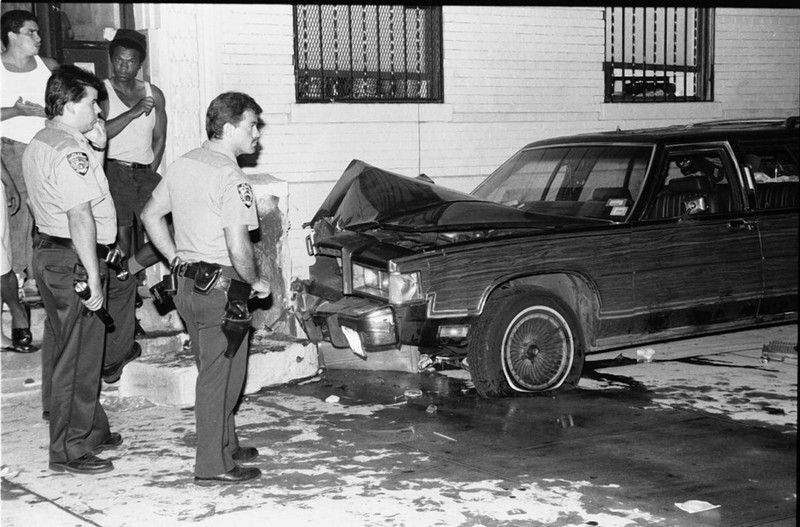Death of Gavin Cato
Introduction
Text-to-speech Audio
At around 8:20 pm on August 19, 1991, a three-car motorcade was heading down President St. in the Crown Heights neighborhood of Brooklyn, NY. The motorcade was led by an unmarked police vehicle, which escorted a car carrying Rebbe Menachem Mendel Schneerson, the leader of the Jewish Chabad-Lubovitch sect, who was returning from visiting the graves of his late wife and father-in-law. The last vehicle in the convoy was a station wagon driven by 22-year-old Yosef Lifsh.
As the motorcade crossed the intersection of President St. and Utica Ave., Lifsh’s car collided with another. Due to conflicting testimony, it is unclear whether the traffic light was still yellow or already red when his car crossed the intersection. According to a government report, Lifsh must have been driving 45 to 50 mph , well above the 30 mph speed-limit. Lifsh lost control of the vehicle and crashed into the sidewalk and slid down the side of an apartment building. Two seven-year-old cousins of Guyanese descent, Gavin and Angela Cato, were struck by the car. Gavin, who had been adjusting his bicycle chain, was pinned between the car and the building and died instantly. Angela was injured but would survive.
The first emergency service to arrive was an ambulance from the Hatzalah, a private ambulance service operated by the Hasidic Jewish community. By the time of its arrival, a small group of Black residents had gathered. By many accounts, these individuals were beating Lifsh, the driver of the station wagon. The Hatzalah EMTs loaded Lifsh into the ambulance and sped away. A city ambulance and another Hatzalah ambulance later took Gavin and Angela to the Kings County Hospital.
The fact that Lifsh, who was not seriously injured in the accident, was prioritized for medical care and quickly driven away from the scene by the Jewish ambulance personnel while the Black children he had gravely injured were left behind caused outrage among many in the local Black community. Jews defended the fact by arguing that an angry crowd had formed, that the men who had occupied the station wagon had been dragged out of the vehicle by the crowd, and that Lifsh had to be evacuated to avoid being beaten. By some accounts, a police officer on scene directed the ambulance drivers to remove Lifsh from the scene to deescalate the situation.
Images
Aftermath of the accident that claimed the life of seven-year-old Gavin Cato and seriously injured his cousin

Backstory and Context
Text-to-speech Audio
At around 8:20 pm on August 19, 1991, a three-car motorcade was heading down President St. in the Crown Heights neighborhood of Brooklyn, NY. The motorcade was led by an unmarked police vehicle, which escorted a car carrying Rebbe Menachem Mendel Schneerson, the leader of the Jewish Chabad-Lubovitch sect, who was returning from visiting the graves of his late wife and father-in-law. The last vehicle in the convoy was a station wagon driven by 22-year-old Yosef Lifsh.
As the motorcade crossed the intersection of President St. and Utica Ave., Lifsh’s car collided with another. Due to conflicting testimony, it is unclear whether the traffic light was still yellow or already red when his car crossed the intersection. According to a government report, Lifsh must have been driving 45 to 50 mph , well above the 30 mph speed-limit. Lifsh lost control of the vehicle and crashed into the sidewalk and slid down the side of an apartment building. Two seven-year-old cousins of Guyanese descent, Gavin and Angela Cato, were struck by the car. Gavin, who had been adjusting his bicycle chain, was pinned between the car and the building and died instantly. Angela was injured but would survive.
The first emergency service to arrive was an ambulance from the Hatzalah, a private ambulance service operated by the Hasidic Jewish community. By the time of its arrival, a small group of Black residents had gathered. By many accounts, these individuals were beating Lifsh, the driver of the station wagon. The Hatzalah EMTs loaded Lifsh into the ambulance and sped away. A city ambulance and another Hatzalah ambulance later took Gavin and Angela to the Kings County Hospital.
The fact that Lifsh, who was not seriously injured in the accident, was prioritized for medical care and quickly driven away from the scene by the Jewish ambulance personnel while the Black children he had gravely injured were left behind caused outrage among many in the local Black community. Jews defended the fact by arguing that an angry crowd had formed, that the men who had occupied the station wagon had been dragged out of the vehicle by the crowd, and that Lifsh had to be evacuated to avoid being beaten. By some accounts, a police officer on scene directed the ambulance drivers to remove Lifsh from the scene to deescalate the situation.
Sources
Dawkins, Wayne. City Son: Andrew W. Cooper's Impact on Modern-Day Brooklyn. University Press of Mississippi, 2012.
Esparza, Jesse J. "Crown Heights Riot." The Encyclopedia of African American History, 1896 to the Present. Oxford University Press, 2009.
Ortner, William G. "Jews, African-Americans, and the Crown Heights Riots: Applying Matsuda's Proposal to Restrict Racist Speech." Boston University Law Review (November 1993): 897-918.
Associated Press
